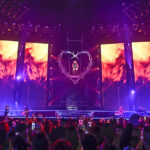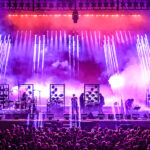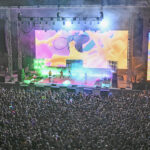Dave Maxwell’s Production Design Supports a Legendary Guitarist
Eric Clapton has enjoyed a long career of live performances all over the globe. A little while back he turned 70 and announced his retirement from the touring circuit. But not from performing entirely. He just wanted to do it on his own terms. For the past 22 years, Dave Maxwell has looked after keeping the artist illuminated amongst other things as they traveled.
They are both quite happy with the current schedule of live events for the year as the artist has chosen to play residency-type scheduling in four different venues from London to New York City, Los Angeles and Tokyo. It’s been eight years since anyone has had to get on a tour bus, “This schedule suits us all well.” the LD proclaims.

The Rig
PLSN caught up with Dave for the first of two shows at the famed Madison Square Garden on March 19 and 20, which kicked off the 2017 tour schedule. Clapton first played this venue in 1968 with Cream. They loaded the gear in, day of show, with a new design that Dave created for both the MSG shows in New York and the following weekend’s gigs (March 25 and 26) at the Forum in Los Angeles.
Dave has never used this particular system, but he feels confident. The Maxwell family resides not far from the Upstaging facility in Sycamore, IL, outside Chicago. The lighting vendor provides him access to their pre-viz suite whenever Dave needs it. He spent a week there, then hung the light rig and video in the warehouse for a week prior to the show for him to program.
When one looks at the stage from front of house, they see a unique looking structure. There is a 56-foot-wide by 12-foot-tall letterbox formation of 10mm video tiles made up of Martin’s EC10 series. For a change, Dave had decided to use video as something more than just low-res wallpaper behind the artist, as he had done often in the past, usually on a large scale. “This year, I wanted to incorporate more of Eric’s hands and work on the guitar. I had heard requests for this before and we are celebrating 50 years of the man’s career here, so I thought it would be nice. But I didn’t want any large wall upstage. I opted for a high-resolution product. Then I split this wide screen into seven separate sections that I could manipulate however I wanted with content. This gives me negative space between the modules, and I can fill that area with lights or darkness, to accent the look.” The LD has some Martin MAC Viper Profiles and Solaris Flares poking through at times. Upstaging provided the video elements on stage as well as the lighting and media servers for the U.S. shows.
“I’m big on gaps and curves,” Dave says, which is clearly evident in the show’s design. The upstage video elements curve outwards at an angle and live on the ground. Directly above the video is a truss no more than 15 feet off the ground with a row of Ayrton MagicPanels across the bottom and a row of Chauvet Nexus Panels across the top. “The MagicPanels are my wash light of choice, because they can do so much. For this design, I incorporate a bunch of Nexus Panels at various levels from the floor to the ceiling to wash the arena in color and do some playful chases. I am also using MAC Viper Air FX as my wash lights.”
Way up high above the stage is a lighting grid, made up of six curved sections loaded with MAC Viper profiles and MagicPanels. “The two outside curves serve as side trusses and curve out toward the front, where I have some front light that hits the band from angles. There really is no front truss on the design I use in America,” Dave explains. The curves sit at symmetrically staggered heights in a way that is pleasing to the eye.
There is a good 20 feet of black space between the top of the video wall and the overhead curves. Dave fills some of that space with a single straight truss filled with more Viper profiles. “I call this the ‘mid truss.’ While it’s not a typical mid truss located over center stage, from the front it sits at mid height in this arena. It separates the video wall from the overhead rig. At any given time, I can separate all these elements into sections. I can go from an intimate acoustic look, with all the lower level lights on and his fingers playing guitar across the screens, then make it big and powerful when he launches into ‘Sunshine of Your Love.’”
“I want Eric to feel comfortable on stage,” Dave continues. “The negative space between the video walls can give him some space and sense of reference. If he turns around to look at his drummer, I don’t want him to stare into a large video surface that fills his entire eyesight. The gaps give separation that is comforting and allows your eye to pick out certain spaces.”
The History
Dave started out back in the 1990s as a tour lighting programmer, using a variety of consoles. “I started on the Avo, banging faders, then moved on up to the ICON desk before the Hog 3. Nowadays I’m quite comfortable with the grandMA2 as my choice to run all of this.”
In 1996, he found himself in Australia, pressing buttons on an Oasis tour where they seemed to cancel as many shows as they played. “I got a call from Mick Double, a friend of mine, who was Eric’s production manager. They were looking for a new LD, and we had worked together before. The next week I was slated to go back home to Ireland. But I found myself with a great new job.” Dave was 24 years old when this happened.
He’s still quick to point out that people tend to stay around with this organization. Many of the staff have alternated between working with Eric and the Who. Not him, though. “I’m still the new guy out here. Well, me and Hannah Charlesworth, our production manager these days. She started with us about the same time.”
So how does an Irish LD end up living outside of Chicago, one may ask? “We had used another vendor for a while and decided a change was due. Our rigger, Bill Spoon, was keen on Upstaging, and told stories of their virtues. Mick and I spoke for a while about options, and somewhere along the way a call was made to John Huddleston over at Upstaging. We knew of them and their reputation for good prep and top notch gear. Hud and Robert Carone paid us a visit somewhere in Europe, and we had a very productive meeting. They have looked after all our needs ever since, including what you see on the stage here.”
After realizing that none of his clients or work was in Ireland anymore, and that he was spending more and more time programming at the Upstaging complex, the Maxwell family decided to make their move from Dublin to the Chicago area. “We had talked about raising our kids in the U.S., so, given the chance, we made a decision to locate the family to America for a year to see if everyone liked it. The kids are quite happy here, as are we. My youngest son can speak Chicago Gangsta with no trace of an Irish accent. We’ve obviously decided to stay put for the immediate future.”

Video Concerns
Dave notes that his approach to video has changed. “I’ve gone from using the elements behind the band as visual texturing to incorporating video director Mark Haney’s camera feeds,” he says.
These are normally seen on the side LED screens that Pennsylvania/LA-based Upstage Video provides. “This time around, Mark is sending me a camera feed and a line shot directly into my Catalyst media servers. Then I can mix the live imagery in with content behind the stage at times, or just let it take over. The lag time is minimal on the playback, and I don’t really notice it. I would say that I am alternating between 50 percent content and 50 percent camera shots this time around.”
Haney, named VP of operations for Upstage Video about the same time they moved to new digs in Lititz, PA a few months back, has been cutting cameras for Clapton’s shows for 10 years. “If Dave is the new guy, I’m on the short list for sure,” Mark admits.
On the side of the stage are some screens being fed live shots from his switcher via a couple of Barco 20K projectors. Upstage Video has built custom flypacks for their directors that have the latest capabilities along with modifications requested by Mark, who is based on the West Coast and works with Upstage Video’s team in Los Angeles.
“We have the usual long lens camera at front of house as well as some handhelds, robocams and lipsticks placed around,” Mark says. “I was happy this year when Dave came to me and asked how we could sort out getting the camera feeds to him. He always has control of a camera on Eric as well as the line cut. He’s doing some interesting blending, and the show is just a labor of love for all of us. Couldn’t work for a nicer group and, hey, the guy’s a legend we can all listen to every night.”
Mark has to give a shout out to the “Coach,” Jim Malone. He has been his right-hand engineer on quite a few shows, having shaded cameras on various Clapton shows for over 20 years. “Coach made my screens sparkle tonight. He’s an artist at shading cameras and being right there for me, night after night. We have another guy named Pete Thornton out here who is just the best all-around video guy I’ve ever worked with. He can do it all, from direct, to engineer, work with projectors or operating a camera. He’s a tremendous asset.”
As for working with Maxwell, Haney heaps the praise. “In all my time with Dave, I have never had to ask him for more level on an artist. He pays attention to color temperatures, foot candles, and it’s just a luxury for me to be able to depend on an LD for that. Plus, his looks are phenomenal.”
Changes
While there are only four venues on this year’s schedule, they are somewhat different outside of America. Eric chose prestigious theatrical venues over more arenas. The same rig that Dave uses at these American shows changes for the ones at the Royal Albert Hall coming up this year.
“The Albert Hall is not an easy load in,” Dave explains. “Lovely building, but the stage shape, rigging availability and time constraints make it near impossible to load this show in and perform in the same day. I will switch to straight trusses and 200 MagicPanels for that show.”
Prior to the Royal Albert Hall shows, set for May 22, 24 and 25, Dave plans to go to the Neg Earth facility in London to pre-program the show again before loading in. “When we play the Budokan in Tokyo, I have weight limits, so we will have a hybrid system between the two existing programmed shows.”
Lighting is just one of the things Dave does for this artist. He operates his own video suite in his home, often providing the content for his own artists. “I’ve grown to love tinkering with video. The tour is sponsored by Chase Bank. I find myself shooting B rolls around town. I use this as alternative footage that I intercut with the main shot and make videos they can play for advertisement. I will go to London soon to shoot some stuff there before returning here to finish it off.”
Dave manages to keep busy filling the holes in his schedule with gigs for other artists and corporate events, but right now he’s happy with his schedule. “I have an artist who will call on a Tuesday to tell me about a show happening on Thursday. If I’m available, I do it, but I’m really quite happy to just disappear to Tokyo or somewhere for a mere week, then come back to my loving family as soon as possible.”
Crew
- Production Designer: Dave Maxwell/brightreddesign.com
- Lighting Co: Upstaging
- Upstaging Crew Chief: Mike “Goose” Hosp
- Upstaging Crew: Joann Wooi, Nick Pishghadamian, Josh “Cuddles” Wilson, Christian Alvarado, Kile McClure, Elliot Harney
- Video Director: Mark Haney
- Video Co: Upstage Video
- Upstage Video Crew: James “Coach” Malone (EIC), Peter Thornton (Projectionist/Cameras), Robbie Lawrence, Corby Anderson, “Legs” Dave Driscoll, Mark Johnson (Cameras), Greg Brown (Video Support/EIC)
- Tour Production Manager: Hannah Charlesworth
- Tour Manager: Peter Jackson
- Tour Assistant: John Collins
- Tour Accountant: Matt Swanson
- Tour EC Technician: Dan Dearnley
- FOH Sound: Robert Collins
- Production Coordinator: Mahina Gannet
- Stage Manager: Trevor Sellers
Gear
- Lighting
- 2 grandMA 2 Full consoles
- 72 Martin MAC Viper Profiles
- 24 Martin MAC Viper AirFX fixtures
- 74 Ayrton MagicPanel-602 fixtures
- 37 Chauvet Nexus 4×4 panels
- 12 Solaris Flares
- 2 Lycian M2 2500W followspots
- 3 DF-50 hazers w/fans
- 39 Sections of Hud truss
- 57 One-Ton Chain Hoists
- 16 Stations of I-Com
- 1 I-Com base station
Video
- 210 Martin EC-10 10mm Panels
- 2 Catalyst Media Servers
- 3 Martin P3-200 Processors
- 1 Custom Flightpack/PPU
- 1 Grass Valley Kayak 2.5 M/E switcher
- 1 Panasonic 450 multi format switcher
- Sony 1500 Series Broadcast Cameras
- Panasonic HD Robo Cameras
- Sound Devices Pix 270i hard drive recorders
- Barco 20K projectors


